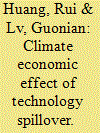| Srl | Item |
| 1 |
ID:
181793


|
|
|
|
|
| Summary/Abstract |
There is increasing interest in the global CO2 emissions transfer caused by international trade. However, the reduction potential of technology spillover is rarely considered. More importantly, the effect of technology spillover on climate change and the social cost of carbon (SCC) should be further investigated to inform climate policy-makers. In this study, we investigate the climate economic impact of technology spillover through unidirectional coupling of the emissions embodied in bilateral trade (EEBT) method and the dynamic integrated model of climate and economy (DICE). The results indicate that technological progress in the electricity sector could contribute to climate change mitigation and SCC lowering. The trade-related CO2 emissions of key CO2 exporters could be substantially reduced, such as China, India, Russia, and resource- and labor-intensive countries. High-tech countries outsourced large amounts of CO2 emissions to labor- and resource-intensive countries. However, a large income gap remains between high-tech and labor/resource-intensive countries. These results indicate the great importance of technological progress and sustainable management throughout the global supply chain.
|
|
|
|
|
|
|
|
|
|
|
|
|
|
|
|
| 2 |
ID:
113004


|
|
|
|
|
| Publication |
2012.
|
| Summary/Abstract |
The volume of China's high-technology exports has grown sharply since the implementation of its export promotion strategy "Revitalizing Trade through Science and Technology" in 1999. This paper investigates whether technology spillover effects are greater for high-technology exports than for primary manufactured goods exports. We present a generalized multi-sector spillover model to identify both between-spillover effects from exports towards non-exporters and within-spillover effects among export sectors. Using panel data for 31 provinces in China over the period from 1998 to 2005, we find that although high-technology export sectors have higher productivity compared with other sectors, this productivity advantage does not lead to technology spillover to both domestic sectors and other export sectors, and export technology spillover mainly derives from traditional export sectors rather than high-technology export sectors. As such findings can be largely attributed to the fact that China's high-technology exports depend significantly on processing trade by foreign-invested firms, policy implications are discussed in relation to how to best promote the role of China's high-technology exports during economic expansion.
|
|
|
|
|
|
|
|
|
|
|
|
|
|
|
|
| 3 |
ID:
113012


|
|
|
|
|
| Publication |
2012.
|
| Summary/Abstract |
Does foreign direct investment (FDI) into developing countries affect the growth of local firms in host countries? Using a dataset of 38 sectors in China's electrical and electronics industry, in this paper, we analyze whether FDI has a positive effect on local firms, with technology spillovers, added value and increasing total factor productivity, or a negative, market stealing, effect. Estimating the relationship between growth of local firms and investment of foreign firms, our results show that FDI is likely to have a negative impact on the growth of local firms in sectors with large disparities in technology and less experience in business. Therefore, local firms lacking in technology need to find markets with no competition from foreign firms or determine strategies to compensate technology disparities.
|
|
|
|
|
|
|
|
|
|
|
|
|
|
|
|
| 4 |
ID:
128163


|
|
|
|
|
| Publication |
2012.
|
| Summary/Abstract |
This paper examines differences in the spatial and temporal variations of rice yields in China and Brazil. Our analysis indicates that, in China, rice yields have converged over time and rice production has become increasingly homogeneous. In contrast, rice yields in Brazil have diverged over time, primarily due to variations in upland rice yields. Three hypothetical explanations may account for the different behaviors of rice yields in Brazil and China, namely: 1) differences in production systems (i.e. irrigated in China vs. upland in Brazil); 2) changes in rainfall patterns; and 3) bias in agricultural research and development (R&D) towards irrigated rice. Our empirical analysis supports the first two hypotheses by establishing that: 1) upland rice shows much more variation in yields compared to irrigated rice; and 2) changing rainfall patterns have primarily affected upland rice. We also provide evidence of the bias towards irrigated systems by looking at the patterns of varietal release.
|
|
|
|
|
|
|
|
|
|
|
|
|
|
|
|